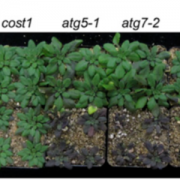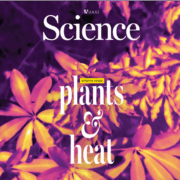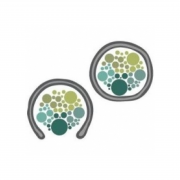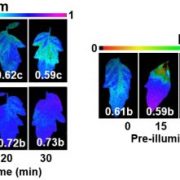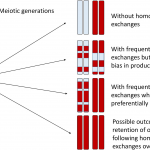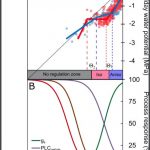How to Eat One’s Feelings: Autophagy and Phosphatidylinositol 3-Phosphate
Moving around taught me two essential skills, only one being relevant here: how to put up wallpaper, and how critical it is to label boxes to help the moving company drop them at their intended location. Now think of a cell: the boxes are vesicles, their contents are proteins and metabolites, and the starting location and final destination of these vesicles will depend on the type of protein/metabolite and the growth environment. Like any good packing champion, plant cells label their assortment of vesicles, not with a sharpie but with phospholipids like phosphatidylinositol 3-phosphate (PI3P) to dictate their intended destination(s). The decoration of vesicles with PI3P is especially important during autophagy, whereby cells recycle proteins and their trapped amino acids through trafficking to the vacuole (Noack and Jaillais, 2017).
The biosynthesis of PI3P relies on PI3 kinases (PI3Ks), for which plants are thought to employ a single protein complex catalyzing its biosynthesis. In Arabidopsis (Arabidopsis thaliana), the single PI3K VACUOLAR PROTEIN SORTING 34 (VPS34) forms a complex with three accessory proteins: VPS15, AUTOPHAGY-RELATED 6 (ATG6), and either ATG14 or VPS38. As might be expected, disrupting PI3P biosynthesis spells trouble for the proper delivery of cargo within the cell. Unfortunately, single loss-of-function mutations in VPS34, VPS15 or ATG6 cannot be maintained in the homozygous state in Arabidopsis, underscoring the critical importance of PI3P but making a genetic dissection very challenging.
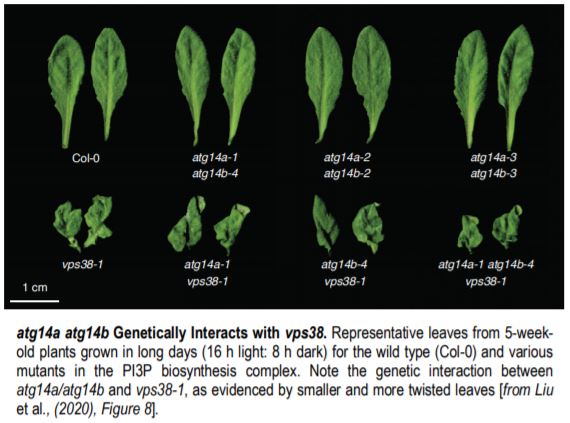 In their recent article, Liu and colleagues (2020) turned to the remaining subunit of the complex, which is filled either by ATG14 or VPS38. The authors hypothesized that loss of function in ATG14 (encoded by two genes in Arabidopsis: ATG14a and ATG14b) would result in milder phenotypes and allow a genetic analysis. vps38 mutants had been previously shown to be viable but were characterized by smaller rosettes with twisted leaves, along with alterations in endosomal sorting (Lee et al., 2018; Liu et al. 2018). By contrast, double mutants inactivating both ATG14 copies, generated via genome editing, exhibited normal leaves and rosettes, indicating that ATG14 is not essential. However, a closer inspection showed a clear disruption of autophagic transport, establishing that ATG14 and VPS38 have non-redundant functions in the PI3K complex. Like other components of the autophagic machinery, the authors then showed that ATG14 associates with autophagic vesicles that are themselves imported into vacuoles.
In their recent article, Liu and colleagues (2020) turned to the remaining subunit of the complex, which is filled either by ATG14 or VPS38. The authors hypothesized that loss of function in ATG14 (encoded by two genes in Arabidopsis: ATG14a and ATG14b) would result in milder phenotypes and allow a genetic analysis. vps38 mutants had been previously shown to be viable but were characterized by smaller rosettes with twisted leaves, along with alterations in endosomal sorting (Lee et al., 2018; Liu et al. 2018). By contrast, double mutants inactivating both ATG14 copies, generated via genome editing, exhibited normal leaves and rosettes, indicating that ATG14 is not essential. However, a closer inspection showed a clear disruption of autophagic transport, establishing that ATG14 and VPS38 have non-redundant functions in the PI3K complex. Like other components of the autophagic machinery, the authors then showed that ATG14 associates with autophagic vesicles that are themselves imported into vacuoles.
Surprisingly, the expected prediction that atg14a atg14b vps38 triple mutant plants would be non-viable, just like mutants eliminating the other three PI3K components, turned out to be false, as the authors were able to find viable triple mutant plants, although at lower frequencies than anticipated (see Figure). The existence of the triple mutant raised an obvious question: do ATG14 and VPS38 even affect PI3P synthesis? The answer was yes but not completely. From arduous phospholipid assays, only a 50% reduction in PI3P levels was seen in the triple mutant, suggesting that the PI3K VPS34 may work without this fourth subunit, or that plants utilize another yet to be discovered PI3K components. To specifically address this point, the authors relied on the inhibitor wortmannin, which is specific to VPS34. While wild-type Arabidopsis seedlings showed a mild growth suppression when exposed to low concentrations of wortmannin, the triple mutant was severely compromised, suggesting that the VPS34-containing PI3K is likely the sole source of PI3P in Arabidopsis.
As a geneticist, discovering that your favorite gene is essential is both rewarding and disappointing because the associated phenotypes are rather dull and technically challenging to work around. With this work, Liu and colleagues describe a complement of single, double, and triple mutants altering function in non-essential subunits of the PI3K complex to reveal the essential functions of the whole complex. Combined with chemical inhibition of PI3P biosynthesis, the results described here provide the foundation for a meticulous dissection of PI3P biology at a biochemical, cellular and physiological level.
Patrice A. Salomé
Science Editor
ORCID: 0000-0003-4452-9064
REFERENCES:
Lee HN, Zarza X, Kim JH, Yoon MJ, Kim S-H, Lee J-H, Paris N, Munnik T, Otegui MS, and Chung T (2018). Vacuolar trafficking protein VPS38 is dispensable for autophagy. Plant Physiol. 176: 1559-1572.
Liu F, Hu W, and Vierstra, RD (2018). The vacuolar protein sorting-38 subunit of the Arabidopsis phosphatidylinositol-3-kinase complex plays critical roles in autophagy, endosome sorting, and gravitropism. Front. Plant Sci. 9: 781.
Noack LC, and Jaillais Y (2017). Precision targeting by phosphoinositides: how PIs direct endomembrane trafficking in plants. Curr. Opin. Plant Biol. 40: 22-33.


